Rosanjin
 Saturday, January 5, 2008 at 03:14PM
Saturday, January 5, 2008 at 03:14PM  Kaiseki is a Japanese tradition from Kyoto that features long multi-course meals in which beautiful presentation is as important as the food on the plate.
Kaiseki is a Japanese tradition from Kyoto that features long multi-course meals in which beautiful presentation is as important as the food on the plate.
Until a year ago, Sugiyama, which carries three stars from the Times, had the Manhattan Kaiseki market almost to itself. It is getting more crowded. Rosanjin opened in late 2006 in TriBeCa. Later this year, David Bouley plans to open Brushstroke just a few blocks away.
Rosanjin doesn’t call much attention to itself—a problem you can rest assured Bouley won’t have. Paul Adams and Frank Bruni were the only mainstream critics to review it. Bruni awarded two stars—relegating it to the indiscriminate scrum of earnest neighborhood joints, pizza places, and steakhouses that have caught his fancy. Forbes awarded four stars, calling it “[one of] the most divine Japanese meals you’ll ever experience in New York.”
Dinner at Rosanjin moves at a quiet and leisurely pace, with the $150 prix fixe meal unfolding over many hours. There are only seven tables, and I get the idea that they are seldom fully booked. There were just two other parties when we were there, and that was on a Saturday night.
The owner, Jungjin Park (who is from Korea) choreographs a tiny staff, who could be part of a ballet. Every plate, no matter how tiny, is placed or retrieved individually with two hands. Mr. Park is the only one who speaks, which he does in such quiet tones that one feels almost obligated to whisper, even when he is not within earshot. There is no menu. You are served whatever Mr. Park is offering that day.
Mr. Park’s collection of sake decanters belongs in a museum. For us, he produced a sphere resembling a tea-pot, with a removable center core that he filled with ice. At another table, the decanter looked like a tall vase. We asked him why he chose one or the other. He replied, “It is according to my mood.”
I felt that flash photography would be inappropriate, and unfortunately the photos don’t do full justice to the beautiful creations that come out of Rosanjin’s kitchen.
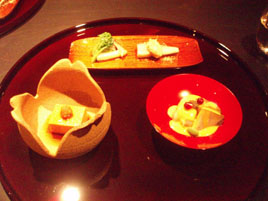
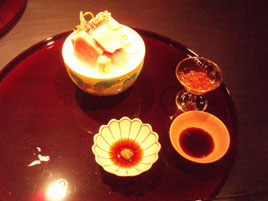
The first course (above left) had three contrasting dishes: 1) monkfish liver with tofu and sesame paste (lower left of photo); 2) Japanese clam with brocolli rabe, white asparagus and brussels sprout (top); 3) grilled fresh scallop in a squash puree (bottom right). All three were impeccably assembled and gorgeous, with the monkfish liver especially standing out.
I didn’t photograph the second course, which came in a lovely black bowl decorated with painted pink flowers. Inside was a fish broth with lobster, fried tofu, two pieces of string bean, and orange rind.
The third course (above right) had pieces of raw snapper, medium fatty tuna, squid and codfish on a bed of shredded radish and shiso leaf. Alongside was a bowl of fresh salmon roe, which Mr. Park advised us to drink like fruit juice and two contrasting sauces for the fish.

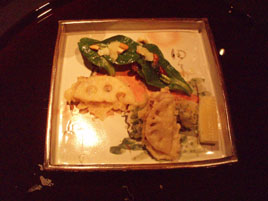
The sushi course (above left) presented the evening’s only choice: fatty tuna or eel. Mr. Park commended our judgment when we both chose the tuna, which was heavily marbled like a ribeye steak. He told us it was a rare variety from the cold waters between Japan and Russa that is seldom available in New York. According to Mr. Park, 99.5% of it goes to Japan, Boston, Spain, and Croatia.
Next came Kobe beef tempura (above right), spinach salad with walnuts and pecorino Romano. This course was one of the evening’s few duds. Kobe beef feels like a default luxury, but I hardly tasted much beef at all—Kobe or otherwise.
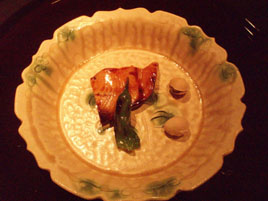
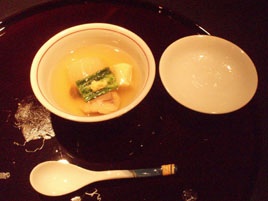
Next, a slice of baby yellowtail teriyaki (above left) came with a blade of “shishito” bean and two ginko nuts (“break with your hands and enjoy”). It was impeccable and beautiful, like everything else, and we enjoyed the texture of the warm fish against the cool lima bean. But I didn’t feel that cooked fish was the kitchen’s strength.
Waves of flavor and contrast washed over us, and I don’t recall any specific impression of simmered codfish (above right) with a radish, Japanese spinach and ginger.
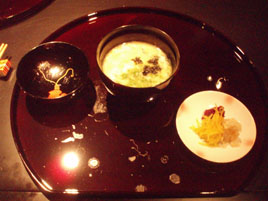

The savory portion of the meal ended with a striking soup (above left) of egg white, vegetable and turtle (“which is very much a delicacy in Japan”), with pickled vegetables. Dessert (above right) was yet another striking combination — crème brûlée, chocolate ice cream and mango juice — though none of these items alone would have been especially memorable.
As this was our first kaiseki experience, I don’t have anything to compare it to, except for the long tasting menus in Western restaurants. But there was only one clear miss (the tempura) dampening the parade of truly exquisite creations, served in a serene environment that almost makes you forget you’re in Manhattan. We will certainly be back.
Rosanjin (141 Duane Street between West Broadway & Church Street, TriBeCa)
Food: ***
Service: ***½
Ambiance: ***
Overall: ***




Reader Comments (1)
I enjoyed your post on Rosanjin, as I do many of your posts which I follow on your RSS feed. For our recent meal and post on Rosanjin see:
http://countryepicure.wordpress.com/2007/12/22/rosanjin-ny-2/
I tried to be discreet with the flash on my tiny camera, but I still used it.